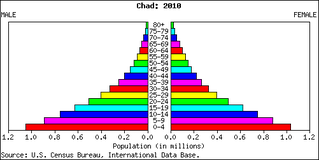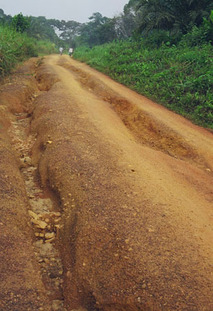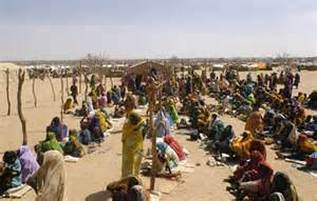Natalistic Policy
Chad does not have an official natalist policy. However, by analyzing their population pyramid and seeing that they have a wide base and extremely narrow top of the pyramid, it can be concluded that Chad has a high death rate and as a result they need a high replacement level most likely above 2.1 to sustain the population and have enough people to farm and work for the family, which means high birth rates as well. It can also be concluded that since Chad has a high death rate, their sanitation and available medical treatment are very scarce, meaning that they probably also have a high infant mortality rate. These characteristics make Chad a country in the Stage 1 phase of the Demographic Transition Model. As a result of these aforementioned characteristics, it is most likely nationally implied that being pro-natalist in Chad is a socially acceptable and probably even expected trait due to their lifestyle as a country in Stage 1.
 Population Pyramid for Chad, Illustrating Stage 1 of the Demographic Transition Model
Population Pyramid for Chad, Illustrating Stage 1 of the Demographic Transition Model
Government Strategies
Chad is a Least Economically Developed Country (LEDC) , which means that many aspects of the country are unstable and ineffective. Their government is one example. The Chadian government has little influence and therefore allows many aspects of the Chadian lifestyle to carry on as they are without government regulation. The natalist activities of the Chadian citizens are one example where there is little to no regulation. The Chadian government understands that they are a stage 1 country with high death rates and high infant mortality rates at approximately 123.9 infant deaths per 1,000 live births, so therefore they need high birth rates and a high replacement level. Therefore, if anything the government is most likely pro-natalist, but being pro-natalist in Chad has become a such a culturally normal thing that the government has little to no need for strategies regarding natalist policy. This is very much unlike China, which has a strictly enforced anti-natalist policy and elaborate punishment strategies for families who exceed the "One Child Policy" including decreased wages for the rule breaker and his/her co-workers, which results in a lot of peer pressure to not break this rule. Chad is also unlike Japan, which has strategic incentives for large families since they need a larger replacement level per woman to replace the aging population.
Population Momentum and PMF
PMF=Crude Birth Rate (CBR) x Average Life Expectancy at Birth
Chad PMF=44.21 x 48.33=2,136= 2.136
The population momentum factor is the tendency for a population to keep growing even after the time that a replacement level of fertility has been achieved. Chad has a PMF of 2.136 which is greater than one. This means that there are a lot of potential young adults in Chad's future and population will consequently grow as a result of the addition of these potential young adults. However, even though this PMF is very high, it not completely accurate because the birth rate is crude and not exact. Also, the life expectancy at birth is an average and does not represent Chad perfectly so there is bound to be slight fluctuations in this number. Death rates might increase as their lives go on due to disease or other factors.
Chad PMF=44.21 x 48.33=2,136= 2.136
The population momentum factor is the tendency for a population to keep growing even after the time that a replacement level of fertility has been achieved. Chad has a PMF of 2.136 which is greater than one. This means that there are a lot of potential young adults in Chad's future and population will consequently grow as a result of the addition of these potential young adults. However, even though this PMF is very high, it not completely accurate because the birth rate is crude and not exact. Also, the life expectancy at birth is an average and does not represent Chad perfectly so there is bound to be slight fluctuations in this number. Death rates might increase as their lives go on due to disease or other factors.
Push and Pull Factors
The main push factor of Chad is health. Issues such as scarce food, low amounts of sanitized water and few doctors to treat large families definitely is unappealing. This factor is a main reason for the high death rate and high infant mortality rate in Chad. Also, lack of infrastructure is a major push factor. Not having access to hospitals, schools and roads greatly decreases the quality of life for Chad citizens and overall lowers their Human Development Index (HDI).
A main pull factor of Chad is war in neighboring countries, and thus more safety in Chad. Quite often, there will be refugees and emigrants who have left their native countries in search of safety and better living conditions. A recent example of this is the flight of people from Darfur, Sudan to Chad as a result of Sudanese civil war. Other pull factors include resources and attractions. Lake Chad is a major water source for Chad citizens and since water is often a scarce resource in Africa, Lake Chad is an appealing resource to many Africans. Also, the magnificent cliffs of the Tibesti Mountains and other landscape attractions serve as pull factors.
A main pull factor of Chad is war in neighboring countries, and thus more safety in Chad. Quite often, there will be refugees and emigrants who have left their native countries in search of safety and better living conditions. A recent example of this is the flight of people from Darfur, Sudan to Chad as a result of Sudanese civil war. Other pull factors include resources and attractions. Lake Chad is a major water source for Chad citizens and since water is often a scarce resource in Africa, Lake Chad is an appealing resource to many Africans. Also, the magnificent cliffs of the Tibesti Mountains and other landscape attractions serve as pull factors.

Poor transportation options are a main reflection of the poor infrastructure in Chad. Inadequate roads make it extremely difficult to travel long distances. They also prevent efficient manners of education and healthcare since it takes so long to get to school or a hospital.
External and Internal Migration
According to the International Organization for Migration (IOM), Chad's net external migration is -1.9 migrants/1,000 population. This negative net external migration shows that more people are migrating to Chad than migrating out of Chad. This means that the internal migration is greater than the external migration. Therefore, from this information we can conclude that the pull factors outweigh the push factors.

Refugee camps in Chad are abundant. Chad currently hosts about 300,000 refugees in 17 refugee camps and 160,000 internally displaced persons (IDPs) in the eastern and southern parts of the country. These figures give a better visual representation of why Chad has greater internal migration than external migration.
